Laird Thermal Systems Technical Paper
by Greg Ducharme, Product Director, Liquid Cooling Systems
Introduction
Recirculating chillers are an essential component of many modern laboratories, particularly in the analytical, pharmaceutical, chemical, and biotech industries. They play a crucial role in maintaining precise temperature ranges within a process or system by effectively cooling and circulating fluids. This ensures the proper function and accuracy of various equipment and processes, such as lasers, distillation columns, test chambers and analytical instruments. In recent years, there has been a growing emphasis placed on sustainability and energy efficiency in laboratory design, driven by evolving regulations and industry standards. This trend has led to the development of "green labs," which are designed to minimize energy consumption and reduce their environmental impact. One way that green labs can achieve these goals is by using energy-efficient recirculating chillers that utilize environmentally safe refrigerants.
Application Background
A significant portion of laboratory equipment requires precise cooling for thermally sensitive electronics, electronic device cooling, and lab equipment test chambers. Chemical reactions release or absorb heat, requiring precise temperature control to keep the reaction stable. The trend to miniaturize laboratory equipment can also increase the heat flux density heightening thermal challenges. When heat-generating electronics are packaged into smaller housings, there is less physical room for natural airflow and heat dispersion. Waste heat must be dissipated efficiently to ensure proper performance of laboratory equipment and optimal control of chemical reactions in test chambers.
Typical laboratory applications requiring temperature control:
- Chemical Processes - Reactor systems, autoclaves, synthesis, condensation of gases
- Biology - Bioreactors, breeding, fermenters, reaction columns, incubation, cell cultivation
- Oil & Gas - Consistent viscosity of liquids, solidifying point, fuel development
- Industrial Research - Materials testing, environmental simulation, sample temperature control, vacuum chambers, quality control
- Food Science - Food development, temperature simulations, quality checks

Types of Refrigerants
In the 1970s, it was discovered that CFCs were damaging the Earth's ozone layer. This led to the phase-out of CFCs under the 1987 Montreal Protocol, an international treaty designed to protect the ozone layer. In response to the phase-out of CFCs, chemical engineers developed hydrochlorofluorocarbons (HCFCs) as a replacement refrigerant. HCFCs were less damaging to the ozone layer than CFCs, but they were still harmful to the environment.
History of Refrigerants
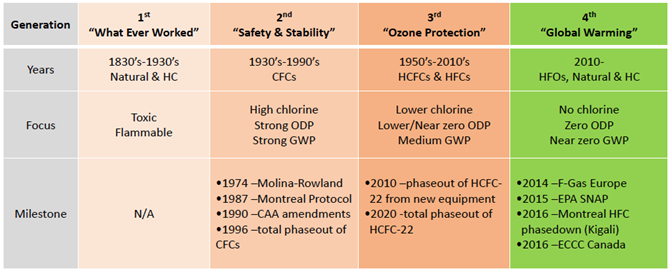
In the 1990s, hydrofluorocarbons (HFCs) were developed as a more environmentally friendly alternative to HCFCs. HFCs do not contain chlorine and are not harmful to the ozone layer. However, they are potent greenhouse gases and contribute to global warming.
Today, there is a push to use refrigerants that have a low global warming potential (GWP). Three factors determine the GWP of a gas:
1. The amount of absorption of infrared radiation by a gas
2. If it absorbs a range of high longwave emissions from Earth, its GWP is higher
3. The longer the gas stays in the atmosphere, the greater the GWP
So, 100-year GWP is based on the energy absorbed by a gas over 100 years.
GWP gases are those that are known to contribute to global warming. These gases can trap heat in the atmosphere, leading to an increase in global temperatures and climate change. The most common GWP gases include:
- Carbon dioxide (CO2)
- Methane (CH4)
- Nitrous oxide (N2O)
- Hydrofluorocarbons (HFCs)
- Perfluorocarbons (PFCs)
Refrigerant ODP & GWP (ODP based on UNEP (2006), GWP – 100 years)
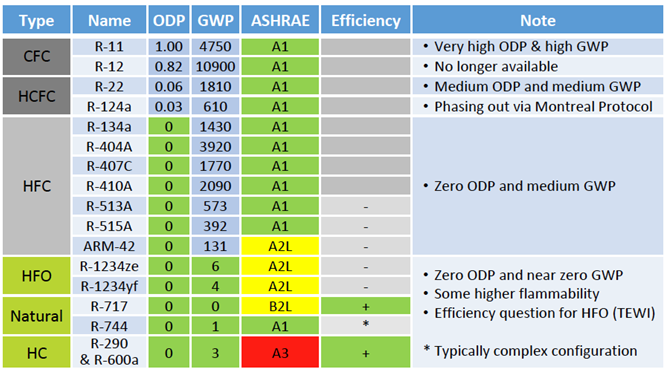
Alternative refrigerants with lower or near zero GWP are available including hydrocarbons like propane (R-290: used today in low-to-medium refrigeration), and isobutane (R-600a: used today in light commercial fridges, freezers, drink dispensers), ammonia (R-717: used in large industrial refrigeration), carbon dioxide (R-744: used in transport, commercial & industrial refrigeration, supermarkets) and new hydro fluoro-olefin (HFO) refrigerants and their blends such as R-1234yf used in European vehicles and R-1234ze used in vending machines, chillers, hermetic compressors.
Alternative refrigerants have received significant consideration for use as future alternatives due to their performance and environmentally friendly characteristics. These characteristics include zero Ozone Depleting Potential (ODP) and near zero GWP. However, these benefits come at the cost of some of these refrigerants being classified as flammable or with increasing levels of toxicity. Next-generation alternative refrigerants are certainly available, however, each one comes with its own individual safety concerns and set of environmental challenges.
ASHRAE Flammability & Toxicity
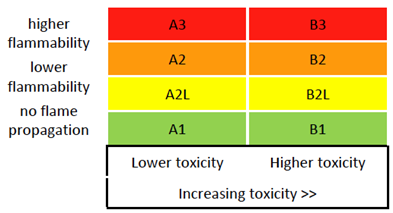
Flammable refrigerants have typically not been used in equipment due to the potential safety risks they pose. Due to increasing concerns of global warming and the corresponding increase in regulatory requirement changes, demands continue to rise for understanding and developing eco-friendly safe systems using flammable refrigerants.
As shown above, many refrigerants used today have an ODP of 0 and a GWP ranging from ~400 to ~4000. As a result, the scientists at Laird Thermal Systems undertook an initiative to develop a new approach using R-290 refrigerant, with an ODP of 0 and GWP of 3.
R290 is a hydrocarbon refrigerant commonly used in air conditioning and refrigeration systems. Although it operates at a higher pressure than R600a, it is a popular choice for larger systems (>1kW) due to its high efficiency and low global warming potential. Chillers using R290 require a charge of <100g, which allows for air freight transport and at the same time limits the amount of cooling. Comparable chillers using R134a refrigerant require up to five times (500g) the refrigerant charge to achieve similar performance. However, R290 is flammable and can be dangerous to handle if proper precautions are not taken. Therefore, following the manufacturer's instructions and guidelines when using and maintaining equipment utilizing flammable refrigerants is imperative.
Governmental and Environmental Regulations and Their Impact on Labs
Governmental and environmental regulations play a significant role in the purchasing decisions for laboratory equipment, particularly regarding refrigerants and energy efficiency. Government and environmental regulations have helped phase out many harmful refrigerants in lieu of more environmentally friendly alternatives.
One such regulation is the F-Gas Regulation (EU Regulation No. 517/2014), which specifically addresses fluorinated gases, including certain refrigerants used in laboratory equipment cooling systems. The F-Gas Regulation sets limits on the production, use, and handling of these gases to reduce their impact on climate change. It promotes the gradual transition to refrigerants with lower global warming potentials (GWPs) and encourages the adoption of energy-efficient cooling technologies.
In addition to the F-Gas Regulation, there are other categories of regulations that impact laboratory equipment:
- Environmental regulations: These regulations may set limits on the types of materials that can be used in the construction of laboratory equipment, as well as the emissions and waste generated by the equipment.
- Safety regulations: Laboratory equipment must meet certain safety standards to ensure that it is safe to use in a laboratory setting. This may include requirements for the design and construction of the equipment (such as isolation of the electrical components from flammable refrigerants in the event of a leak), as well as labels and warning signs.
- Health and hygiene regulations: Laboratory equipment must meet certain health and hygiene standards to protect workers and the public from the risks associated with hazardous materials. These regulations often dictate equipment’s design and material requirements. Quality assurance regulations: Laboratories are subject to quality assurance regulations, which may include requirements for the procurement and maintenance of laboratory equipment.
To meet these regulations, laboratories should consider various certifications and standards.
A laboratory with LEED certification, for example, demonstrates that a laboratory is environmentally responsible, and may also come with tax breaks. ROHS and REACH certification ensure that certain materials, such as metals with high levels of mercury or lead, are not used in components. UL Lab Standards ensure that products are safe for use by laboratory technicians and are electromagnetically compatible with other technologies in the lab.
EN 378 is a European standard for refrigerating systems and heat pumps. It specifies requirements for design, construction, testing, and performance, as well as for their safety, environmental impact, and energy efficiency. The standard covers a wide range of refrigeration and heat pump systems, including stationary and mobile systems, as well as systems for commercial, industrial, and domestic use. EN 378 is intended to provide a common basis for the design, construction, and operation of refrigerating systems and heat pumps across the European Union, and is used as a reference in the design, construction, testing, and certification of these systems.
Additionally, recognized by international licensing bodies, IEC/EN 61010-1 specifies safety requirements for a variety of electrical equipment and their accessories, including test and measurement equipment, industrial process control equipment, and laboratory products.
IEC/EN 61010-2-011 specifies the particular safety requirements of electrical equipment and their accessories, whenever that equipment incorporates refrigerating systems as an integral part of, or separate from, the equipment and the equipment is in direct control of the refrigerating system. This document details all the requirements when up to 150g of flammable refrigerant are used per stage of a refrigerating system.
Recirculating chillers are now rated using the International Organization for Standardization's (ISO) Energy Efficiency Ratio (EER) standard, which measures the ratio of the cooling capacity of the chiller to its electrical input power. Chillers with a higher EER rating are more energy efficient and can help reduce the overall energy consumption of a laboratory. A chiller’s EER rating is one determining factor of whether the device will meet government and environmental regulations like EN 378.
It is important for laboratory managers to be aware of these regulations and ensure that any equipment purchased meets the relevant standards. Failure to comply could result in fines, legal action, and damage to the reputation of the laboratory.
Challenges Facing Low-GWP Alternative Refrigerants
The cost and performance of low-GWP refrigerants play an important role in selecting a chiller platform. GWP refrigerant costs can be affected by several factors, including the amount of refrigerant needed based on cooling efficiency as well as the availability of raw materials, production, manufacturing, and supply and demand. Some GWP refrigerants are becoming scarcer due to demand, driving up the price and making it difficult for companies to obtain these refrigerants.
Government regulations and taxes can also play a role in determining the cost of GWP refrigerants. For example, refrigerants with a higher GWP may be subject to higher taxes or stricter regulations, which can increase their cost.
Some governments and their agencies have restricted the amount of flammable refrigerant that is allowed to be shipped within a single system, which can greatly impact the cooling capacity of alternative-based cooling systems.
Chiller Selection for Sustainable Labs
When developing chiller/refrigerating platforms, the choice of refrigerant is a key factor that determines the architecture and servicing requirements. In sustainable labs, selecting a chiller with a low-GWP refrigerant needs to be a primary consideration.
When it comes to low GWP alternative refrigerants, Laird Thermal Systems most often works with R290 and R600a. Since both are flammable, designing systems with less than 100g of refrigerant is necessary. Due to its thermal characteristics, R600a is limited in its cooling capacity with such a small charge but operates at lower pressures. Therefore, R600a is the refrigerant of choice for applications requiring less than 1kW of cooling. For applications requiring cooling greater than 1kW, Laird Thermal Systems will incorporate the necessary design features to manage higher pressures and utilize the higher thermal capabilities of R290.
Other factors to consider:
Sizing a Chiller –
Properly sizing a recirculating chiller is essential to ensure that the device will be able to effectively cool the area or process it is intended for, while also being energy-efficient and cost-effective. The first step in properly sizing a chiller is to determine the cooling load of the area or process that the chiller will be serving. The cooling load (often measured in Kilowatts) is the amount of heat that needs to be removed from the area or process in order to maintain a desired temperature. This load can be calculated using a variety of methods, including manual calculations or computer simulation and specification software like the Thermal Wizard from Laird Thermal Systems.
Once the cooling load has been determined, there are several factors to consider when selecting a chiller that is capable of meeting the specified cooling load:
- type of chiller (air-cooled or water-cooled)
- type of refrigerant being used
- the required power input
- pump flow and pressure
- system efficiency
When using an air-cooled chiller, it is also important to consider the design of the facility where the chiller will be installed and whether other equipment will be impacted by the system's heat rejection.
High-efficiency chillers are more environmentally friendly as they significantly reduce energy costs and the amount of heat rejected at the installation site, lessening the burden on a building’s HVAC system. Chillers utilizing variable-speed compressors and fans can result in a nearly 50% reduction in energy consumption. It's important to look for a chiller that meets standards for Energy Efficiency Ratio (EER), variable speed motors, coolant maintenance, and system design features to ensure uptime.
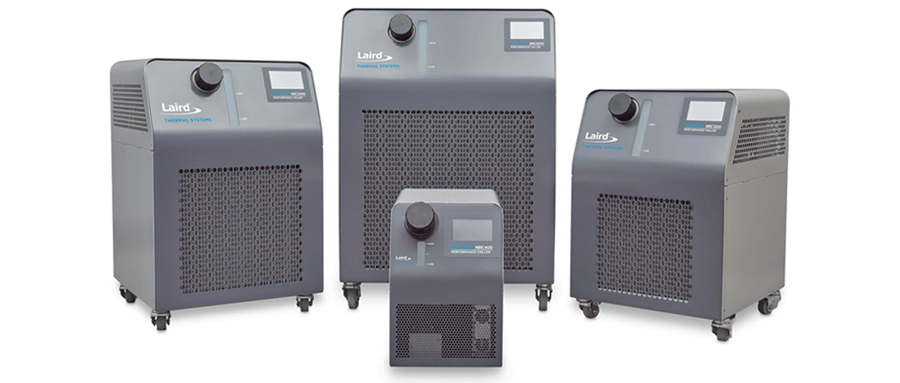
Finally, it's important to consider the maintenance requirements of the chiller and the availability of replacement parts. The chiller must be easy to maintain and repair to minimize downtime and keep it running smoothly and efficiently.
Performance Curves
The performance of a chiller is often described by a set of performance curves, which show how the chiller behaves under different conditions. By understanding these performance curves, users can make better decisions about which product is the right one for their application.
The performance of a chiller is often described by a set of performance curves, which show how the chiller behaves under different conditions. By understanding these performance curves, users can make better decisions about which product is the right one for their application.
Understanding Chiller Performance Curves
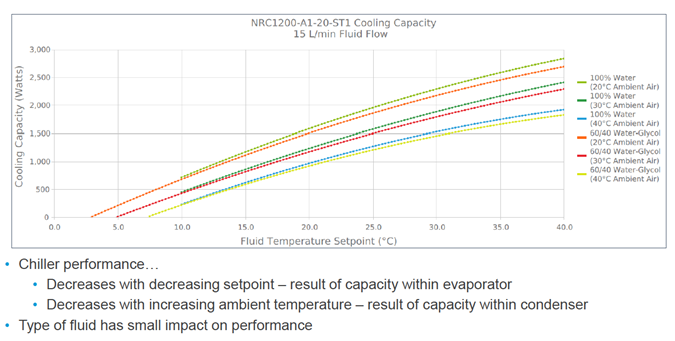
One important performance curve for a chiller is the capacity curve. This curve shows how the cooling capacity of the chiller changes as a function of the coolant setpoint and ambient temperature.
In the case of an air-cooled chiller, the cooling capacity is the amount of heat that the chiller can transfer from the recirculating liquid through the refrigeration system and into the air at the installation site. Understanding the required cooling capacity with respect to setpoint and air temperature at the installation site is critical.
Another performance curve for a chiller is the pump performance curve. Equipment requiring cooling has an internal heat exchanger that has been designed to operate with a specific temperature and flow rate of coolant. Since flow and pressure are closely related, the data on this chart allows a selection of a pump that will guarantee sufficient flow to this internal heat exchanger and proper operation of the equipment.
A third important performance curve for a chiller is the EER curve. This curve shows how the efficiency of the chiller changes as the temperature of the refrigerant changes. The EER is a unitless ratio (Watts / Watts) of the cooling capacity of the chiller to the electrical power input. For chillers with single-speed motors, the EER increases with the amount of chiller cooling capacity being utilized. For example, a 2kW chiller will have a higher COP than a 5kW chiller cooling a 1.5kW application.
In addition, to understand chiller performance curves, the conditions under which the chiller is operating must be identified. Chiller performance varies with conditions such as:
- the load on the chiller (i.e., the amount of cooling required)
- the setpoint of the coolant exiting the chiller
- the ambient temperature at the installation site
- the required flow and pressure of the coolant required by the equipment
By reviewing and analyzing performance curves, users can understand where a chiller is operating efficiently and where it may be struggling in order adjust the operating conditions to improve the overall performance.
Additional Considerations
In addition to energy efficiency, it is also important to consider the desired temperature range and stability, and the specific cooling needs of the equipment or processes being carried out. This will help determine the required size and capacity of the recirculating chiller. The chiller should be appropriately sized for the needs of the laboratory, as an undersized chiller will not be able to meet the cooling demand, while an oversized chiller may be less energy efficient and cost more to operate. Reduction in operating noise as well as reduced heat input to the lab environment also contribute to a chiller being environmentally friendly.
Conclusion
Cooling equipment is a vital component in many laboratory settings, serving a variety of purposes including thermal management of electronics, precise temperature control for incubation and cell growth, and maintaining temperatures for reactions. The customer base for this type of equipment is diverse, including industries such as chemistry, biology, medical, oil and gas, and food science. New refrigerant developments have been marked by a series of technological advances and a shift towards more environmentally friendly options. As concerns about climate change continue to grow, further developments in refrigerant technology are necessary in the future. When selecting a recirculating chiller, it is important to carefully evaluate the options and select a system that meets the laboratory's needs, while complying with relevant government and environmental regulations and considering global impact.
Contact Laird Thermal Systems
Have a question or need more information about Laird Thermal Systems? Please contact us.



